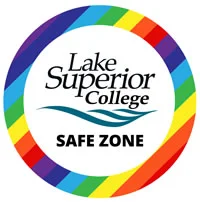Culturally Responsive Pedagogy (CRP) Work
Lake Superior College is a part of the Minnesota State System and is working towards those system goals, specifically Equity 2030. The Center for Faculty Innovation is dedicated to supporting LSC’s progress towards the Equity 2030 goal, specifically by engaging in and offering a variety of activities that are overtly focused on Culturally Responsive Pedagogy.
Some of these activities include:
- Leading book group discussions on titles such as Syllabus: The Remarkable, Unremarkable Document that Changes Everything, Blindspot, and How to Be an Anti-Racist
- Facilitating system-level Culturally Responsive Pedagogy courses
- Embedding equity in CFI trainings
- Including Culturally Responsive Pedagogy-specific concepts in the POET training courses
- Updating Professional Fluency areas of focus to include Cultural Competence
- Pronoun Project
- Partnering with the Executive Diversity Office and the Center for Equity and Inclusion and assuring at least one member of the CFI serves on the Council for Diversity, Equity, and Inclusion
- Ensuring the members of the CFI continue to work on their own equity goals and stay current on diversity, equity, and inclusion best practices and research to engage faculty in this important work.
SafeZone
SafeZone is an LSC initiative to increase awareness and support for GLBTAQI+ students and staff at Lake Superior College. The training is based on the national Safe Zone Project. Over 130 Lake Superior College staff and students have completed SafeZone 1.0 and more are continuing to dive deeper with our SafeZone 2.0. SafeZone is a partnership between the Center for Faculty Innovation and the Center for Equity and Inclusion.

Lake Superior College has also offered SafeZone training to local community and business owners. We have offered Safezone online and in person.
If you are interested in completing training or learning more, please contact Sarah Lyons, Executive Diversity Officer, or Amy Jo Swing, CFI Online Training Coordinator, .
Documents
“What does racial equity mean to us?” Framework
Created by Sarah Lyons (Executive Diversity Officer), Lindsy Mason O’Brien (English Faculty), and Tara McCoy (former Psychology Faculty), Lake Superior College
GOAL: Give departments or programs the opportunity to evaluate themselves through a racial equity lens and create racially-centered goals that are specific to their disciplines and needs.
REASONING: This project supports our commitment to Equity 2030 goals and to being equitable, welcoming campus communities. By focusing on departments rather than individuals, this framework attempts to circumvent personal anxieties surrounding racial equity work through collaborative development or program-specific outcomes.
PEOPLE NEEDED:
- The campus Executive Diversity Officer and at least one Project Coordinator to oversee the process.
- Each department/program that participates also needs a Department Facilitator. Duties:
- Coordinate efforts within their department and conduct the department/program-specific research.
- Gather information from their department colleagues about what, if any, racial equity work is already being done within the department.
- Research racial issues in that discipline, create a summary of concerns and review how other programs (on your campus or other institutions) have dealt with them.
- Research contributions from people of other in their discipline.
- Create and report on goals related to increasing equity in their department/program. With the Project Coordinator(s), they fine-tune their goals, set timelines, and identify potential barriers to achieving the department/program’s goals.
- Librarians: helpful in assisting with research.
Before you begin, basic equity training should be provided at the beginning of the project for all participants. This should be provided before participants begin evaluating their departments. Additionally, anyone who serves in a Coordinator type of role should have training in CRP practices and be prepared for collaborative group and one-on-one conversations.
Also note: Participants should be held accountable for specific content and receive feedback at regular intervals throughout the process.
D2L PROJECT GUIDE:
We recommend you create a course in D2L, enrolling all participants, to help guide them through the process.
CONTENT:
“Before You Begin” module: contains information about learning about race and racism. You might include videos or articles defining institutional racism, implicit bias, more area- or campus-specific information about race.
Module One:
This is where the analysis of what’s been done in the program/department begins. Use the Finding a Starting Place, Part One document to guide that work. Then, use the Finding a Starting Place, Part Two document to summarize the work.
Module Two:
This is where faculty can start to research equity-related concerns within the field of the specific department/program. Faculty are looking for specific resources and information that will come in handy when creating goals in Module Three. Faculty are encouraged to reach out to librarians for assistance in finding resources relevant to the specific department/program.
Module Three:
This is when the actual goal setting happens. This module will include:
- Basic information on setting SMART goals. Faculty should consider what outcomes they hope to achieve with their goals, how they’ll know when they’ve achieved the goals, and what timeline they will have for achievement.
- Examples of the types of goals that could work for this and more information to support the creation of those goals. Different areas that goals could be focused on include:
- Syllabus and course information
- Instructor accessibility, availability, and approachability
- Course or program outcomes
- Access to required materials and technology
- Course content
- Assignments and assessment
- The Goal Setting Form
Department Facilitators can then complete a report using the following questions or prompts as a guide:
- Based on your research in Module 1, what was the state of equity work in your department or program prior to engaging in this program?
- While researching in Module 2, what sorts of information did you seek out?
- Document your specific and measurable goals (3-5 per department/program) and a plan to achieve these goals. Each goal was asked to define the following:
- What is your specific and measurable goal?
- How did you come to this goal? What equity-related concern is it addressing and what research did you find in support of your strategy?
- What is the intended outcome of the goal?
- How will you measure your progress?
- What is the timeline for achieving this goal? What steps will you take, and when will you see progress?
- What stands in the way of achieving this goal and how will you overcome any barriers?
DISCUSSIONS: Used as a space for conversation and questions about the project; a way to connect easily with other participants.
ASSIGNMENTS: Where documents and reports are uploaded.
Upon completion of the project, it is up to the individual campus to determine what the next steps are in the process of reporting and assuring that goals are pursued into the future.

